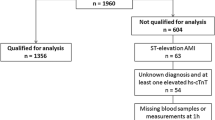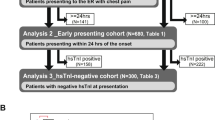Abstract
Background
The aim of the current study was to evaluate the diagnostic and intermediate-term prognostic impact of C-terminal portion of provasopressin (copeptin) in combination with troponin I.
Methods
In this prospective single-center study we recruited a total of 230 unselected patients with suspected recent acute coronary syndrome (ACS) presenting consecutively at our chest pain unit. Troponin I and copeptin levels were determined at presentation and after 3–6 h. Follow-up was performed after 180 days.
Results
Acute myocardial infarction (AMI) was the final diagnosis in 107 patients (STEMI: 24, NSTEMI: 83). The median copeptin level was significantly higher in patients having AMI than in those without (20.83 vs. 12.2 pmol/L, p < 0.0001). A troponin I level <0.04 ng/mL in combination with copeptin <14 pmol/L at admission ruled out AMI with an negative predictive value (NPV) of 97.3 %. p = 0.0045 for the added value of copeptin to troponin I. Kaplan–Meier analysis showed that copeptin levels above the diagnostic cut-off were associated with an elevated intermediate-term (180 days) mortality (p = 0.019), while no patient with copeptin values below the cut-off died. Univariate Cox regression analysis identified copeptin as strong predictor of intermediate-term mortality (HR 4.28, 95 % CI 1.58−11.6, p = 0.004). The predictive performance for prediction of 180-day mortality was significantly better if copeptin was included (C-index of 0.80) compared with that of troponin alone (C-index 0.78, p = 0.01 for the added value of copeptin to troponin I).
Conclusions
Additional assessment of copeptin allows a rapid and reliable exclusion of AMI and improves diagnostic accuracy in myocardial ischemia. This study showed for the first time that copeptin provides valuable predictive information for risk stratification and intermediate-term outcome in ACS patients.




Similar content being viewed by others
Abbreviations
- ACS:
-
Acute coronary syndrome
- AMI:
-
Acute myocardial infarction
- AVP:
-
Arginine-vasopressin
- AUC:
-
Area under the curve
- CAD:
-
Coronary artery disease
- CAG:
-
Coronary angiography
- CI:
-
Confidence interval
- CV:
-
Coefficient of variation
- cTnT:
-
Cardiac troponin T
- ECG:
-
Electrocardiograph
- ED:
-
Emergency department
- GRACE:
-
Global registration of acute coronary events
- HR:
-
Hazard ratio
- HscTnT:
-
High-sensitivity cardiac troponin T
- IQR:
-
Inter quartile range
- NPV:
-
Negative predictive value
- NSTEMI:
-
Non-ST-segment elevation myocardial infarction
- PPV:
-
Positive predictive value
- ROC:
-
Receiver operating characteristics
- STEMI:
-
ST-segment elevation myocardial infarction
- TIMI:
-
Thrombolysis in myocardial infarction
References
Hamm CW, Bassand JP, Agewall S et al (2011) ESC Guidelines for the management of acute coronary syndromes in patients presenting without persistent ST-segment elevation. The task force for the management of acute coronary syndromes (ACS) in patients presenting without persistent ST-segment elevation of the European society of cardiology (ESC). Eur Heart J 32:2999–3054
Melanson SE, Morrow DA, Jarolim P (2007) Earlier detection of myocardial injury in a preliminary evaluation using a new troponin I assay with improved sensitivity. Am J Clin Pathol 128:282–286
Mueller M, Celik S, Biener M et al (2012) Diagnostic and prognostic performance of a novel high-sensitivity cardiac troponin T assay compared to a contemporary sensitive cardiac troponin I assay in patients with acute coronary syndrome. Clin Res Cardiol 101:837–845
Tousoulis D, Kampoli AM, Stefanadi E et al (2008) New biochemical markers in acute coronary syndromes. Curr Med Chem 15:1288–1296
McCann CJ, Glover BM, Menown IB et al (2008) Novel biomarkers in early diagnosis of acute myocardial infarction compared with cardiac troponin T. Eur Heart J 29(23):2843–2850
Kurz K, Giannitsis E, Becker M et al (2011) Comparison of the new high sensitive cardiac troponin T with myoglobin, h-FABP and cTnT for early identification of myocardial necrosis in the acute coronary syndrome. Clin Res Cadiol 100:209–215. doi:10.1007/s00392-010-0230-y
Reichlin T, Hochholzer W, Stelzig C et al (2009) Incremental value of copeptin for rapid rule out of acute myocardial infarction. J Am Coll Cardiol 54:60–68. doi:10.1016/j.jacc.2009.01.076
Keller T, Tzikas S, Zeller T et al (2010) Copeptin improves early diagnosis of acute myocardial infarction. J Am Coll Cardiol 55:2096–2106. doi:10.1016/j.jacc.2010.01.029
Gu YL, Voors AA, Zijlstra F et al (2011) Comparison of temporal release pattern of copeptin with conventional biomarkers in acute myocardial infarction. Clin Res Cardiol 100:1069–1076. doi:10.1007/s00392-011-0343-y
Stoiser B, Mortl D, Hulsmann N et al (2006) Copeptin, a fragment of the vasopressin precursor, as a novel predictor of outcome in heart failure. Eur J Clin Invest 36(11):771–778
Khan SQ, Dhillon OS, O’Brien RJ et al (2007) C-terminal provasopressin (copeptin) as a novel and prognostic marker in acute myocardial infarction: leicester acute myocardial infarction peptide (LAMP) study. Circulation 115:2103–2110. doi:10.1161/CIRCULATIONAHA.106685503
Von Haehling S, Papassotiriou J, Morgenthaler NG et al (2012) Copeptin as a prognostic factor for major adverse cardiovascular events in patients with coronary artery disease. Int J Cardiol. doi:10.1016/j.ijcard.2011.12.105
Apple FS, Smith SW, Pearce LA, Ler R, Murakami MM (2008) Use of the centaur TnI-ultra assay for detection of myocardial infarction and adverse events in patients presenting with symptoms suggestive of acute coronary syndrome. Clin Chem 54:723–728
Itoi K, Jiang YQ, Iwasaki Y, Watson SJ (2004) Regulatory mechanisms of corticotrophin-releasing hormone and vasopressin gene expression in the hypothalamus. J Neuroendocrinol 16:348–355. doi:10.1111/j.0953-8194.2004.01172.x
Morgenthaler NG, Struck J, Alonso C, Bergmann A (2006) Assay for the measurement of copeptin, a stable peptide derived from the precursor of vasopressin. Clin Chem 52:112–119. doi:10.1373/clinchem.2005.060038
Katan M, Morgenthaler N, Widmer I et al (2008) Copeptin, a stable peptide derived from the vasopressin precursor, correlates with the individual stress level. Neuro Endocrinol Lett 29:341–346
Staub D, Morgenthaler NG, Buser C et al (2009) Use of copeptin in the detection of myocardial ischemia. Clin Chim Acta 399:69–73. doi:10.1016/j.cca.2008.09016
Giannitsis E, Kehayova T, Vafaie M, Katus HA (2011) combined testing of high-sensitivity troponin t and copeptin on presentation at prespecified cutoffs improves rapid rule-out of non-ST-segment elevation myocardial infarction. Clin Chem 57(10):1452–1455
Narayan H, Dhillon OS, Quinn PA et al (2011) C-terminal provasopressin (copeptin) as a prognostic marker after acute non-ST elevation myocardial infarction: leicester acute myocardial infarction peptide II (LAMP II) study. Clin Sci (Lond) 121(2):79–89
Voors AA, von Haehling S, Anker SD et al (2009) C-terminal provasopressin (copeptin) is a strong prognostic marker in patients with heart failure after an acute myocardial infarction: results from the OPTIMAAL study. Eur Heart J 30(10):1187–1194. doi:10.1093/eurheartj/ehp098
Urwyler SA, Schuetz P, Fluri F et al (2010) Prognostic value of copeptin: one-year outcome in patients with acute stroke. Stroke 41:1564–1567
Potocki M, Reichlin T, Thalman S et al (2012) Diagnostic and prognostic impact of copeptin and high-senstivity cardiac troponin T in patients with pre-existing coronary arter disease and suspected acute myocardial infarction. Heart 98:558–565
Celik S, Giannitsis E, Wollert KC et al (2011) Cardiac troponin T cencentrations above the 99th percentile value as measured by a new high-sensitivity assay predict long-term prognosis in patients with acute coronary syndromes undergoing routine early invasive strategy. Clin Res Cardiol 100:1077–1085. doi:10.1007/s00392-011-0344-x
Lotze U, Lemm H, Heyer A, Muller K (2011) Combined determination of highly sensitive troponin T and copeptin for early exclusion of acute myocardial infarction: first experience in an emergency department of a general hospital. Vasc Health Risk Manag. 7:509–515
Acknowledgments
The authors are indebted to Mrs. Renate Kwiotek from the Institute of Clinical Chemistry and Laboratory Medicine for her excellent technical assistance and, of course, all patients who agreed to participate in the study. B.R.A.H.M.S GmbH, Hennigsdorf, Germany provided us reagents and kits for the copeptin assay. They played no role in the design of study, choice of enrolled patients, review or interpretation of data, or preparation or approval of manuscript. Jörn Ole Vollert and Sabine Hertel are employees of BRAHMS GmbH, part of Thermo Fisher Scientific.
Conflict of interest
On behalf of all authors, the corresponding author states that there is no conflict of interest.
Author information
Authors and Affiliations
Corresponding author
Rights and permissions
About this article
Cite this article
Afzali, D., Erren, M., Pavenstädt, HJ. et al. Impact of copeptin on diagnosis, risk stratification, and intermediate-term prognosis of acute coronary syndromes. Clin Res Cardiol 102, 755–763 (2013). https://doi.org/10.1007/s00392-013-0583-0
Received:
Accepted:
Published:
Issue Date:
DOI: https://doi.org/10.1007/s00392-013-0583-0




